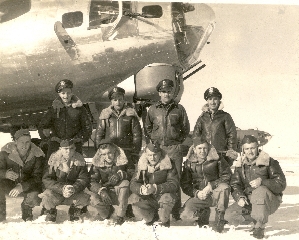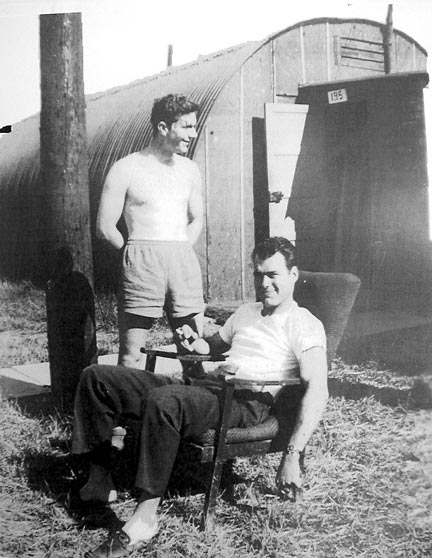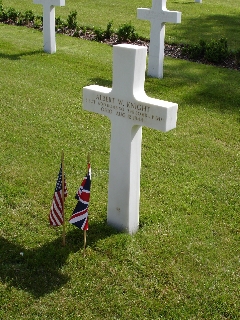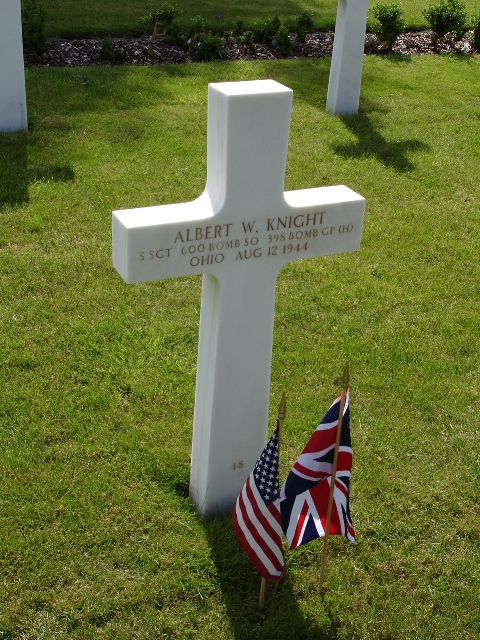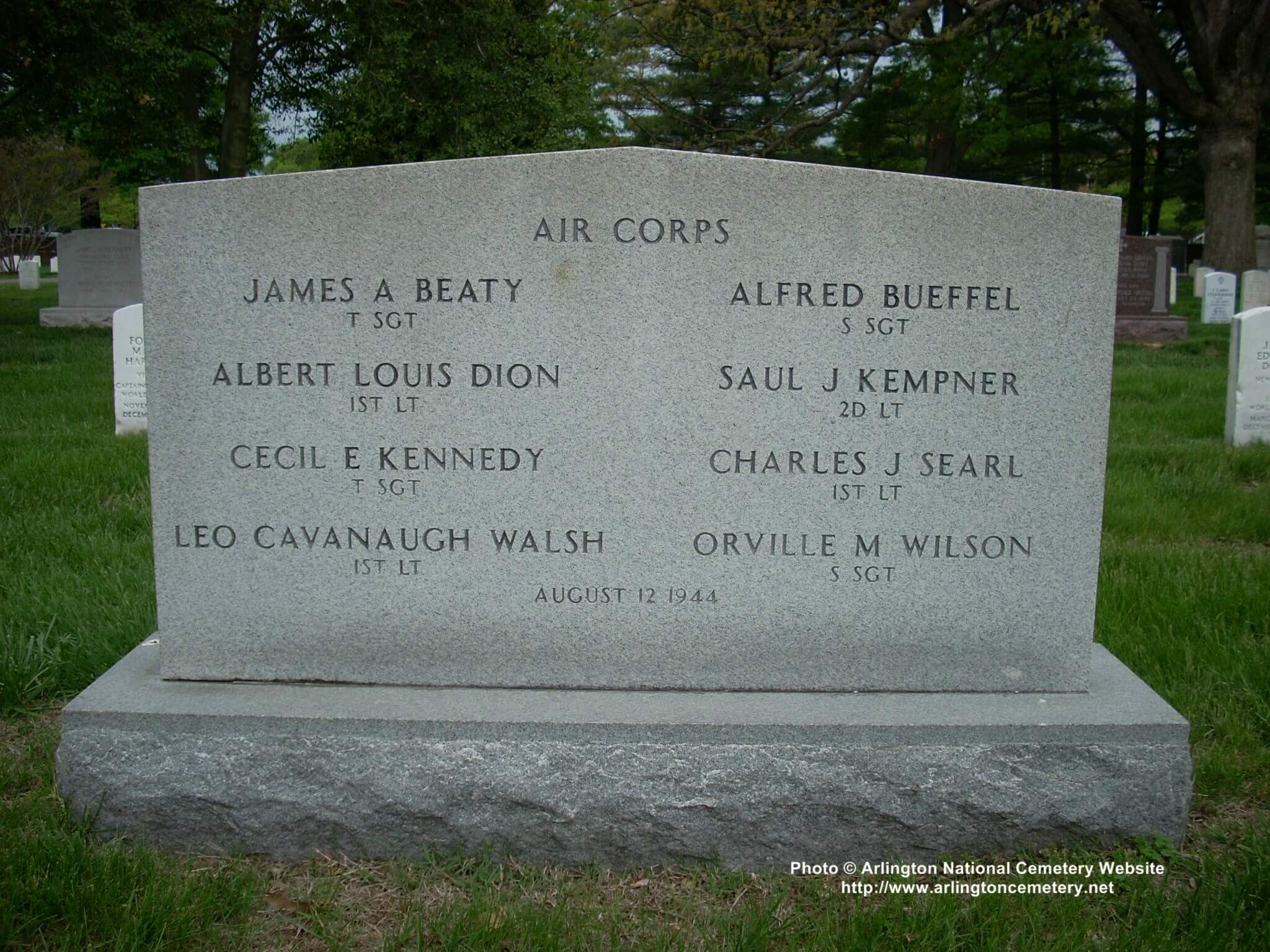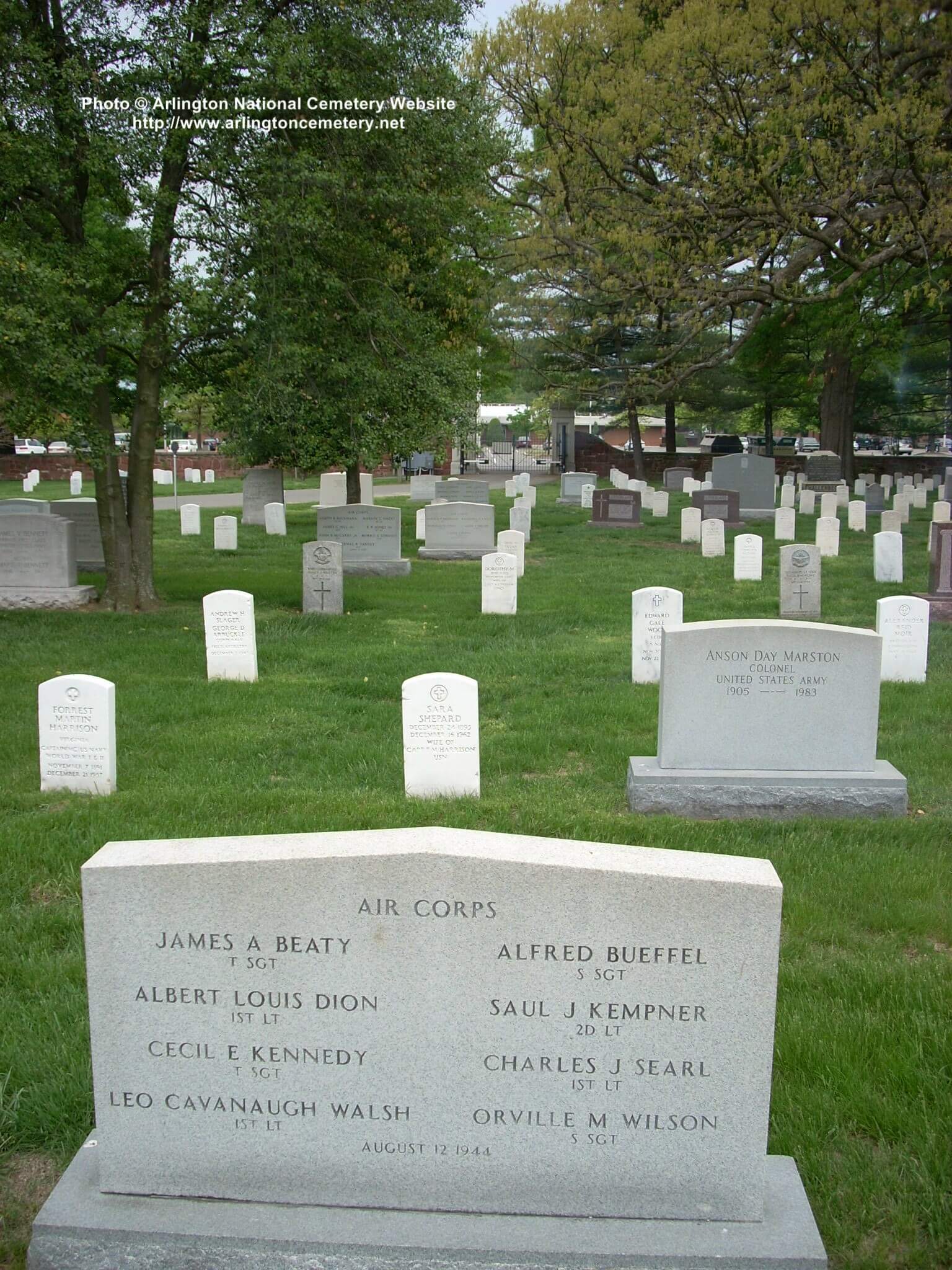B-17 “Tomahawk Warrior” – A Tribute
to the Charles J. Searl Crew
Saturday, 12 August 1944 – a B-17 bomber named the “Tomahawk Warrior” and nine young men came into the history of Penn forever. Many years have gone by – some of the elders of Penn who remembered that day have passed away and a new generation born. They can only read of the sacrifice made by the “Tomahawk Warrior” and her crew.
The nine young men who flew that morning died long before their time on their 25th mission. Only a few more to fly and they would have been going home to loved ones and a full and happy life ahead.
This is their story……
The 398th Bomb Group was one of the last to arrive in this country during March 1944. They flew their B-17’s from Newfoundland to England to the allotted aerodrome of Nuthampstead near Royston in Herts where the countryside was very similar to that which surrounds Penn. To one crew their B-17 was special to them and as was usual the Pilot, Charles Searl, named it the “Tomahawk Warrior” after the small town where he lived. There was a crew of ten to fly her and a skilled ground crew to care for her. The first mission was to Berlin on the 19th of May. They returned safely and one can only feel that they were relieved and jubilant.
Charles Searl was married with a daughter of 18 months and he and his wife were expecting another addition to the family in July. He was 23 and had enlisted in the Air Force soon after Pearl Harbor. As far as records show none of the other nine crewmembers were married and their ages ranged from 20 to 27. They had come from many states across the USA… Wisconsin, Massachusetts, Michigan, Washington, D.C., Arkansas, Virginia, Ohio and New York.
The “Tomahawk Warrior” flew many missions including a D-Day one to targets at Caen and Courseulles, France. Missions were interposed with leave which one supposes they spent in London. Their evenings would be spent at the local Inn just on the edge of the airfield and at Royston, the nearest small town. Entertainment would have been laid on at the base along with dances and there must have been invitations from the local population.
By June the “Tomahawk Warrior” had completed sixteen missions, all with the same crew. July recorded only five missions. During this month Charles Searl must have received news of the birth of a second daughter, sadly he was never to see.
From August 1st the “Tomahawk Warrior”, still with her original crew, flew missions to France and Germany and on the morning of the 12th were on their twenty-fifth to Europe, Versailles, France. The day was dull and overcast with low cloud. Just before take-off, the tenth member of the crew stepped down from the flight. It has never been sure why. All that is known of him is his name and rank and after the “Tomahawk Warrior” crashed he was returned to America and so survived the war. No trace of him was ever found.
The crew of nine took off at 0618. Formation was hazardous with the bad weather as the plane climbed to reach height. By 0700 the “Tomahawk Warrior” was heading out Southeast and already in trouble. One engine was seen to be on fire, and as it turned over the town of High Wycombe to return to base, a second engine was seen also on fire. Below in the town was the HQ of the 8th Air Force and most likely monitoring the mission. It has always been accepted that the pilot was trying to find open ground to attempt a landing when he had no chance of reaching his base or even Bovingdon airfield which was only ten miles away to the North. He would have seen the populated area he was flying over and realized the devastation the plane would cause if it crashed there. It skimmed over the farmhouse of Lude Farm and crashed into open fields opposite. “Tomahawk Warrior” and its crew of nine young men ended life in a massive explosion and fire. No one had bailed out of the stricken plane and no distress signal was ever traced. They stayed together, comrades now for all eternity. One of the crew was found in the lane and two at the edge of the fields. The rest were identified by their dog tags. A short entry in official records at their base read, ‘Takeoff 0618 hours, 0720 no return’. Such a short epitaph.
No investigation took place as to the reason for the crash. It was just one more casualty of war. General Doolittle, who was at the HQ in High Wycombe, visited the scene of the crash later in the day.
The field where the “Tomahawk Warrior” crashed is the same today as it was fifty-seven years ago. Beautiful, peaceful and the seasons come and go. It is an everlasting memorial to duty and sacrifice. They that died need no other.
The following are the names of those that died that morning:
Pilot: Charles J. Searl Wisconsin
Co-Pilot: Albert L. Dion Massachusetts
Navigator: Saul J. Kempner Michigan
Bombardier: Leo C. Walsh Washington, D.C.
Radio/Gunner: Cecil E. Kennedy Virginia
Eng / TT Gunner: James A. Beaty Arkansas
Ball Turret Gunner: Alfred Bueffel New York
Right Waist Gunner: Albert W. Knight Ohio
Tail Gunner: Orville M. Wilson Washington, D.C.
They were all buried in Cambridge Cemetery but after the war, in accordance with the wishes of their relatives, eight of them were re-interred in Arlington Cemetery, America. They sleep amongst the highly honored in America. The one who was left behind, Albert Knight, also with his parent’s wishes, is honored yearly by the Chiltern Aircraft Research Group on the anniversary of the crash with flowers and thoughts of the eight lying in their home country.
Each Armistice Day Penn Church remembers them in the service and reads their names out along with others who gave their lives from the village. Small American Flags are placed along the path by the church door, each with the name of the “Tomahawk Warriors” crew, and usually the Battle Hymn of the Republic is sung in honor. The Book of Remembrance in Penn Church has their names inscribed in glorious memory.
To all who read this tribute, remember… they gave their lives just as bravely and in sacrifice for peace, just as those who were lost on and over the battlefields of Europe.
The Searl Crew:
Photo Coordinator For 398th Bomb Group Website, July 2008
Leo C. Walsh, Bombardier, Seated, Charles J. Searl, Pilot
SEARL, CHARLES J.
United States Army
BURIED AT: SECTION 15, SITE 76
ARLINGTON NATIONAL CEMETERY
KENNEDY, CECIL E.
United States Army
BURIED AT: SECTION 15, SITE 76
ARLINGTON NATIONAL CEMETERY
BEATY, JAMES A
AR United States Army
BURIED AT: SECTION 15 SITE 76
ARLINGTON NATIONAL CEMETERY
WALSH, LEO C
2ND LT US AAF WW II
BURIED AT: SECTION 15 SITE 76
ARLINGTON NATIONAL CEMETERY
DION, ALBERT LEWIS
1ST LT US AAF
BURIED AT: SECTION 15 SITE 76
ARLINGTON NATIONAL CEMETERY
BUEFFEL, ALFRED
AF United States Air Force
BURIED AT: SECTION 15 SITE 76
ARLINGTON NATIONAL CEMETERY
WILSON, ORVILLE M
S/SGT US AAF
DATE OF DEATH: 08/12/1944
BURIED AT: SECTION 15 SITE 76
ARLINGTON NATIONAL CEMETERY
KEMPNER, SAUL J
2ND LT US AAF
BURIED AT: SECTION 15 SITE 76
ARLINGTON NATIONAL CEMETERY
Gravesite of Albert W. Knight, American Cemetery at Madingly, Cambridgeshire, England
Michael Robert Patterson was born in Arlington and is the son of a former officer of the US Army. So it was no wonder that sooner or later his interests drew him to American history and especially to American military history. Many of his articles can be found on renowned portals like the New York Times, Washingtonpost or Wikipedia.
Reviewed by: Michael Howard

